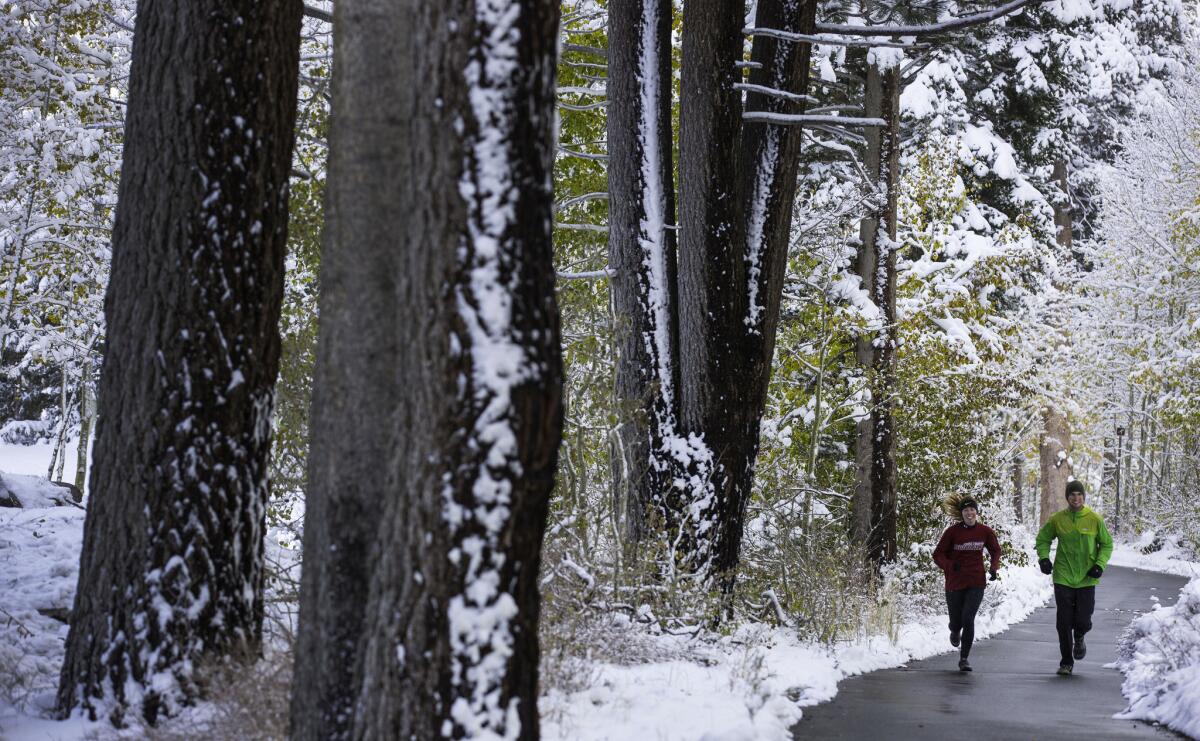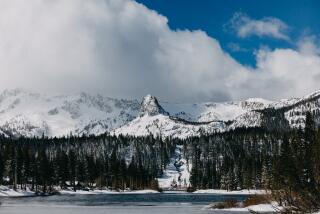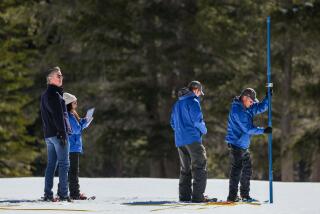Heavy snows in Sierra Nevada raise hopes of relief from drought

A couple run on a trail after a fall Sierra Nevada storm dropped nearly a foot of snow at Mammoth Mountain and less in town in Mammoth Lakes.
- Share via
A day of heavy snow may have turned swaths of the Sierra Nevada into a winter landscape, but it’s too early to tell if it will have a lasting effect on the winter snowpack, forecasters say.
The early November storm dumped more than a foot of snow over Lake Tahoe, according to the National Weather Service, and tourism officials at Mammoth Mountain say that their area received up to 30 inches.
“We’re all keeping our fingers crossed that the predictions of a big ol’ Godzilla El Niño are true,” said Lara Kaylor, spokeswoman for Mammoth Lakes tourism.
NEWSLETTER: Get the day’s top headlines from Times Editor Davan Maharaj >>
After years of drought, weather experts say a powerful El Niño forecast to hit California this winter could make a significant contribution to the state’s water resources — if it falls in the right places at the right pace.
Snowpack is a key factor in California’s water supply: In a normal year, melting Sierra Nevada snow provides the state with one-third of its water. Another third is pumped from aquifers, and the rest comes from rivers and reservoirs.
This spring, researchers found that the amount of water contained in the snow on April 1 was 5% of the average snow water equivalent since monitoring began.
A new federal forecast released in October showed the upcoming El Niño could bring rains into Northern California, reaching more vital reservoirs than previously predicted. El Niño is a weather phenomenon that involves warming sea surface temperatures and a change in wind that alters weather patterns in the atmosphere worldwide.
In Monday’s case, the storm was strong enough to allow the resorts to open early, Kaylor said. Two Mammoth-area resorts are opening Thursday instead of Veterans Day, she said.
But although the weather is a boon for tourism, its effect on the snowpack is far from certain, said Doug Carlson, a spokesman for the California Department of Water Resources.
Water and Power is The Times’ guide to the drought. Sign up to get the free newsletter >>
Replenishing the Sierra Nevada snowpack is “akin to running a marathon,” Carlson said. “It’s sustained work…and we need a lot over a period of time for it to be worth crowing about.”
“The resort owners can’t be faulted for crowing. It’s good marketing. But no one here is jumping for joy at DWR,” Carlson added.
But Monday’s snow and a dusting that followed Tuesday were heavier and earlier than average years and fell in important watersheds, forecasters said.
Even in places where the snow was lighter, it broke records.
Reno-Tahoe International Airport saw more precipitation Monday than it typically does for all of November, National Weather Service meteorologist Dustin Norman said.
Forecasters predict that more snow could come next week and that temperatures may stay below freezing for the next few days, which could help snow accumulation.
“Any precipitation we can get definitely helps. It’s a good start to the winter,” Norman said.
ALSO:
30 sent to hospitals from Halloween raves in Pomona, San Bernardino
Lamb sacrifice performed for man days before he was ejected onto freeway sign
7 passengers kicked off Spirit Airlines flight at LAX; some claim racial discrimination
More to Read
Sign up for Essential California
The most important California stories and recommendations in your inbox every morning.
You may occasionally receive promotional content from the Los Angeles Times.











